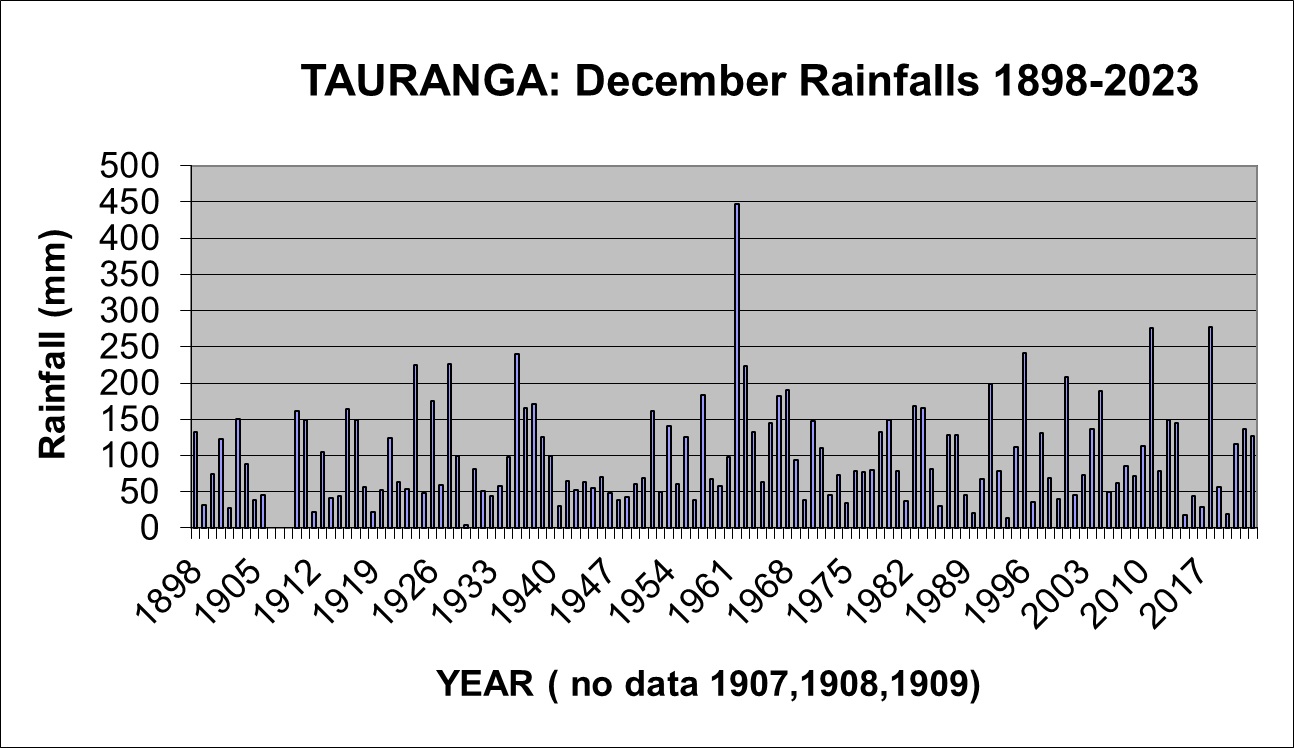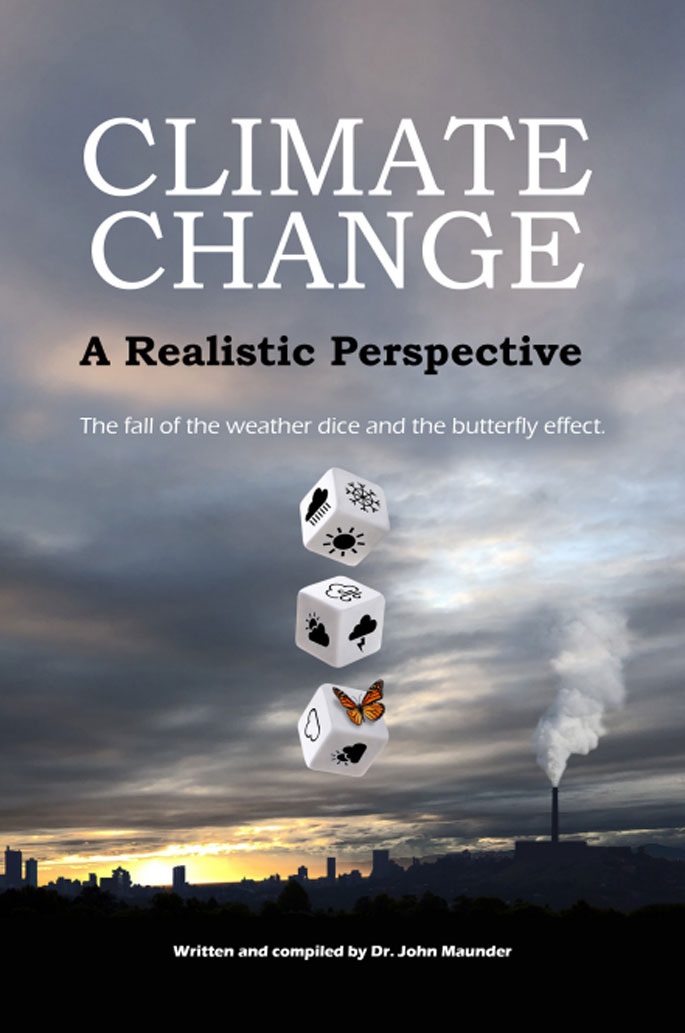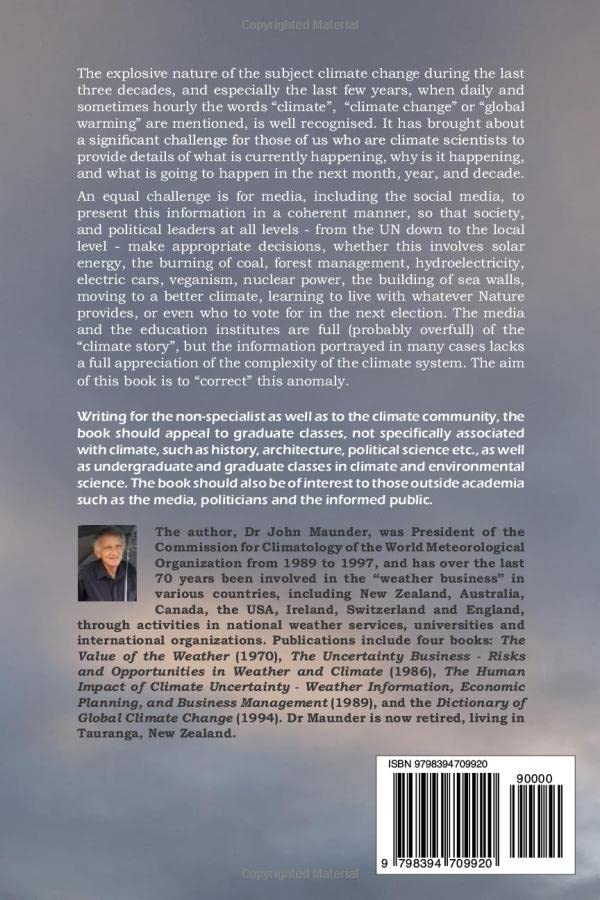 |
Weather Eye with |
The graph below shows the range of Tauranga's December rainfalls, from an extreme high of 447 mm in 1962 to a low of only 4 mm in 1930.
The second wettest December was 2018, when 278 mm was recorded.
The second driest December was in 1994, when only 14 mm fell.
The rainfall for December 2023 was 127 mm.
The long-term average rainfall for Tauranga for December is 100mm. The graph of the December rainfall shows at first glance, normal variations from year to year.
However, there had been an increase in December rainfalls during the last few decades with the average December rainfall in Tauranga for the 50-year period from 1961-2010 of 109 mm, was 20 percent higher than the rainfall for the 50-year period 1911-1960.
In contrast, four recent December months (2015, 2016, 2017, 2020) have had low rainfalls of 18 mm, 44 mm, 29 mm and 19mm.
Since 1898, there have been nine Decembers with a rainfall of 200 mm or more, six of which occurred during the period 1962 to 2018. Nine December months have experienced rainfalls of 30 mm or less.
Of significance are the high rainfalls in the consecutive December months of 1962 and 1963, of 447 mm and 224 mm respectively.
In chronological order, the nine-wettest Decembers are 1924 with 225 mm, 1928 with 227 mm, 1936 with 240 mm, 1962 with 447 mm, 1963 with 224 mm, 1996 with 241 mm, 2001 with 208 mm, 2011 with 276 mm, and 2018 with 278 mm.
In contrast, the ninth-driest December months in chronological order are 1902 with 27 mm, 1912 with 22 mm, 1919 with 22 mm, 1930 with 4 mm, 1986 with 30 mm, 1990 with 21 mm, 1994 with 14 mm, 2015 with 18 mm, and 2020 with 19 mm.

For further information on a range of weather/climate matters see:My new book Climate Change : A Realistic Perspective.....Available from Amazon


Now that I am approaching my 92nd year, it seems appropriate that I should quote the words of Walter Cronkite of CBS fame, whose absolute commitment and reputation for objectivity always signed off his 6pm news bulletin with ..." And that's the way it is".
With so much information and misinformation about the climate story, perhaps the words of Cronkite should be a reminder to us all, including our decision makers and the media, that the sun, the volcanoes, and the oceans dominate the climate system.
Of course, now that we are through the 20th and into the 21st century, one must acknowledge the important human (including domestic animals) influence on the climate system.
However one must also acknowledge that prior to about 1800, the climate variations which occurred (and there were many of them), were not - with very few exceptions - influenced by the activities of humans.
There is a great amount of evidence about detecting changes in the climate, and many reasons/causes of why the climate changes.
Among the evidence for detecting climate change are instrumental records which include satellite observations, extreme weather events, historical records (eg crop records, church attendance), sea level changes, lake varves, glacial advances and retreats, ice cores, rocks, and tree rings.
Among the causes of why the climate changes is methane, carbon dioxide, solar activity - including sunspots, the Earth's orbit and rotation, the Earth's reflectivity, volcanic activity, ocean circulation, generating power, using transportation, producing food, heating and cooling of buildings, planetary cycles (e.g. Milankovitch cycles), and the ever increasing world's population.
In considering both the evidence for climate change and the causes of climate change, there are many questions as to the credibility of the "evidence".
Some of this "credibility" relates to the reliability of the records, and this includes the "authority" making the observations. There have been many cases where the evidence for and the causes of climate change have been challenged.
I have spent the last 70 years studying and writing, as objectively as I can, about the evidence, causes and impacts of climate and climate change.
I have written this book to summarise what I have learned. And, like Walter Cronkite, I would like to sign off with the assurance that, to the best of my knowledge, “And that's the way it is”.
**********************
FOREWORD ( to the First Edition) by John Zillman AO FAA FTSE Former Director (1978-2003) of the Australian Bureau of Meteorology, and Former President (1995-2003) of the World Meteorological Organization
There are probably few people in the world who have originated and accumulated as much detailed knowledge of as many different shades of climate as John Maunder. He is a font of wisdom on climate matters and I believe he has served the world extremely well over the past 50 years through the way he has shared that knowledge and wisdom with the global community. .

